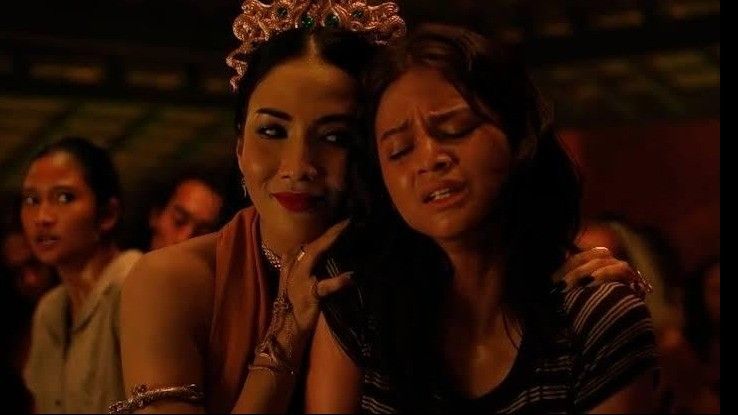
Title: Dancing Village: The Curse Begins
Director: Kimo Stamboel
Cast: Aulia Sarah, Maudy Effrosina, Jourdy Pranata, M. Iqbal Sulaiman, Ardit Erwandha, Diding Boneng, Aming Sugandhi, Dinda Kanyadewi, Pipien Putri, Maryam Supraba
Where: In theatres near you
Rating: 3.5 Stars
This film, a prequel to the hit KKN di Desa Penari, is a visually arresting dive into Indonesian folklore. While the narrative takes its time to build momentum, it offers a richly atmospheric journey through a cursed village haunted by ancient rituals. For those willing to embrace the slow-burn horror, this film delivers a unique blend of culture, myth, and creeping dread.
The story follows Mila (Maudy Effrosina), a young woman tasked with returning a bangle to her mother’s ancestral village. As she ventures deeper into the jungle with her cousin Yuda (Jourdy Pranata) and friends, she encounters the ominous goddess Badarawuhi (Aulia Sarah), who presides over a deadly “dance of death.” The village, steeped in mysticism and tradition, is the perfect setting for a tale where the boundaries between the real and supernatural blur.
Visually, the film is a triumph. Cinematographer Patrick Tashadian captures the jungle’s menacing beauty with a masterful use of light and shadow. The village’s isolation is palpable, with wide, sweeping shots giving way to more claustrophobic frames as the characters fall deeper into Badarawuhi’s grasp. The night-time sequences, in particular, are breathtaking—filled with ghostly figures, flickering lights, and haunting rituals that feel otherworldly and grounded in cultural authenticity. The scenes are mesmerizing, with the possessed villagers moving in eerie unison, their eyes glazed over in terrifying surrender.

Kimo Stamboel's direction leans heavily into the atmosphere, and while the pacing may feel slow at times, it’s clear that the film is more interested in mood and immersion than cheap thrills. This deliberate approach allows the audience to feel the weight of the village’s curse, building tension through subtle, unsettling moments rather than constant jump scares. The practical effects further enhance this grounded feeling, adding a tangible layer to the supernatural events.
Where the film occasionally stumbles is in its character development. Mila, though portrayed with sincerity by Effrosina, lacks emotional depth, and her motivations feel somewhat underexplored. Similarly, the supporting characters—Yuda and his friends—are given little to do beyond escorting Mila on her journey. However, the film’s emphasis on its mythos and the overwhelming presence of the village itself more than makes up for these narrative shortcomings.
The film’s technical strengths stand out. The sound design—hushed whispers and the jungle’s rhythmic hum—builds tension, while the ethereal score enhances unsettling moments. Stamboel’s integration of traditional Indonesian folklore adds cultural richness, elevating the film beyond typical horror. The rituals and beliefs woven into the narrative give it a unique flavour, rooted in its setting yet universally resonant in its themes of fear and superstition.
Overall, with haunting visuals, cultural depth, and mounting tension, this film stands out in the growing horror scene. For those seeking mood over adrenaline, the film captivates, offering a chilling journey toward a quietly unsettling conclusion.